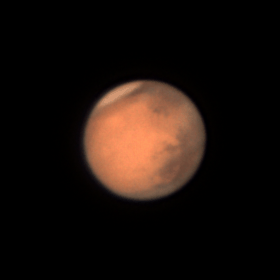Venus
 |
 |
 |
 |
| 1/15/2025 | 1/21/2025 | 1/28/2025 | 2/7/2025 |
FLIR Blackfly S BFS-U3-200S6C camera with C14, combining 50 sharpest / 500 exposures, Palo Alto, CA
As Venus approaches inferior conjunction on March 22, it continues to appear larger and more crescent-shaped.
Moon
 |
 |
| 1/14/2025 | 2/7/2025 |
FLIR Blackfly S BFS-U3-200S6C camera with C14, combining 10 sharpest / 50 exposures, Palo Alto, CA
The left image (click to enlarge) shows the Mare Crisium and Mare Tranquillitatis regions of the Moon when it was still close to full. For scale, Mare Crisium (the dark basin towards the right) is approximately 345 miles in diameter. The right image, taken when the Moon was past first quarter, includes Mare Nubium and the Straight Wall (upper-left area), and Tycho, the crater with the large central peak near the bottom of the image.
Mars
 |
 |
 |
 |
 |
| 1/14/2025 | 1/16/2025 | 1/20/2025 | 1/27/2025 | 2/7/2025 |
FLIR Blackfly S BFS-U3-200S6C camera with C14, each frame combining 50 sharpest / 500 exposures, Palo Alto, CA
Since the length of a Martian day is not very different from our own (approximately 24 hours and 40 minutes), the features visible from a given site on Earth only change slightly from night to night, appearing as a gradual backwards rotation. So one has to observe Mars over a period of weeks to see the entire surface. The above animations show the planet's rotation over approximately half an hour (5 minutes per frame). The North polar cap is prominent in all of the animations. The first two animations on the left also include Olympus Mons (a faint circle visible to the left of center), and the first three animations show Valles Marineris (below a bright triangular peninsula-like feature). The third and fourth animations show the bright Arabia Terra region. The fifth animation shows the bright Elysium Planitia region, as Mars starts to appear noticeably smaller.
Jupiter
 |
 |
| 1/14/2025 | 1/15/2025 |
 |
| 2/7/2025 |
FLIR Blackfly S BFS-U3-200S6C camera with C14, each frame combining 50 sharpest / 500 exposures, Palo Alto, CA
The animation at upper-left covers a time interval of 45 minutes and shows the shadow of the moon Io crossing Jupiter as it rotates. I believe Io is also present to the lower-right of the shadow, but it is difficult to see because it is in front of a reddish-brown band of similar color. The animation at upper-right, acquired from images taken the following day, covers a longer time duration of 200 minutes and shows the eventual emergence of the Great Red Spot. The bottom animation, covering a time interval of 50 minutes, was acquired just after Io had disappeared behind the right edge of Jupiter. It shows Europa to the right of the Jupiter with its shadow crossing the Great Red spot. The left part of the image shows Ganymede (top) and Callisto (bottom).
Saturn
 |
| 1/15/2025 |
FLIR Blackfly S BFS-U3-200S6C camera with C14, combining 200 sharpest / 2000 exposures, Palo Alto, CA
Saturn was too low in the sky to get a very sharp image. Its rings are also nearly edge-on. A ring-plane crossing will occur on March 12 this year (when Saturn is too close to the Sun to observe), but the rings will be nearly edge-on again in November.
Uranus
 |
|
||
| 200 x 0.1s | 90 x 4s |
FLIR Blackfly S BFS-U3-200S6C camera with C14, Palo Alto, CA
The image on the left was made from a series of 2000 exposures, 0.1s each, by selecting the 200 sharpest images and combining them with Registax. These settings were intended to produce the sharpest image of Uranus. To show the much smaller and fainter moons, the images on the right were made from a series of 100 4-second exposures, stacking the 90 sharpest frames in Python. The top image shows the result without sharpening. The part of the image inside the dark circle is attenuated by a factor of 0.0015, to allow Uranus (magnitude 5.7) to be seen alongside its four brightest moons, from left to right: Umbriel (mag. 14.9), Ariel (mag. 14.1), Titania (mag. 13.9), and Oberon (mag. 14.1). The bottom image was sharpened by deconvolution using a Gaussian-type kernel. The green debris towards the right is from a hot pixel on the sensor. Its trajectory is the result of telescope tracking errors.
Neptune
 |
 |
 |
|
| 50 x 0.1s | 90 x 4s |
FLIR Blackfly S BFS-U3-200S6C camera with C14, Palo Alto, CA
The image on the left was made from a series of 500 exposures, 0.1s each, by selecting the 50 sharpest images and combining them with Registax. These settings were intended to produce the sharpest image of Neptune, though my expectations were low due to Neptune's small angular size and low position in the sky. To show Neptune's moon Triton, the images on the right were made from a series of 100 4-second exposures, stacking the 90 sharpest frames in Python. The center image shows the result without sharpening. The part of the image inside the dark circle is attenuated by a factor of 0.015, to allow Neptune (magnitude 7.9) to be seen alongside Triton (mag. 13.8). The image on the right was deconvolved using a Gaussian-type kernel.

